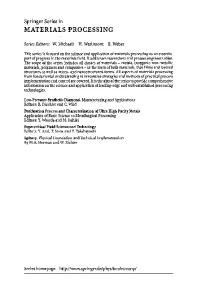Polymer Surfaces and Interfaces
- PDF / 1,781,813 Bytes
- 3 Pages / 576 x 777.6 pts Page_size
- 65 Downloads / 486 Views
16
their applications. The issue begins with an overview of the energetics of polymer interphases, and an illustration of the relationship between surface energy and important properties such as wetting and adhesion. Several approaches to modify surface and interfacial properties are described, and their fundamental bases are discussed. In general, either a low-energy release surface or a highly adhesive interphase is desired. The molecular characteristics of surface-active additives that promote release properties are described. Achieving adhesive interphases in polymers is more challenging, due to the low polarity of many polymers. Several approaches to promoting interfacial entanglements are presented that help to increase interaction across the interphase. The article by Brown expands upon these ideas by presenting a concise summary of recent advances in the understanding of polymer adhesion. The article demonstrates how molecular scale dissipation processes can be related to the mechanics of crack propagation at the crack tip and how local chain processes are involved in adhesion. The behavior of interface coupling agents is elucidated for both glassy-glassy and elastomeric interphases. A brief discussion of the important area of pressure-sensitive adhesives and new tools for characterizing adhesion bring the article to a close. The review by Chakraborty and Tirrell addresses polymer adsorption, a phenomenon essential to many applications including stabilization of colloidal suspensions, paints, coatings, inks, and ceramic processing. The article describes polymer absorption from a fundamental point of view by considering the conformations adopted by polymer chains in a variety of situations. The effects of solvent quality, chain length, surface energetics, and polymer architecture are discussed on a theoretical level and are compared to available experimental results for the molecular structure of adsorbed polymers. The article concludes
with an overview of adsorption of heterogeneous polymers, emphasizing block copolymers. Some parallels between the adsorption of synthetic random copolymers and biological macromolecules (i.e., proteins) are also pointed out. The rapidly evolving field of polymer surface dynamics is addressed in the article by Granick. Beginning with an update on the classic stick-slip phenomena of polymers at an impenetrable wall, the article goes on to consider how the confinement of polymer molecules at interfaces affects chain relaxation processes. A discussion of nanorheology, or interfacial rheology, illustrates that many challenges remain to be answered in the area of surface dynamics and presents some preliminary results that show particular promise in advancing our understanding. The final three articles in the issue demonstrate the incredible advances that have been made in methods for the characterization of polymer interphases. The descriptions of their applications toward understanding important research problems also serve to illustrate important technological features of poly
Data Loading...








